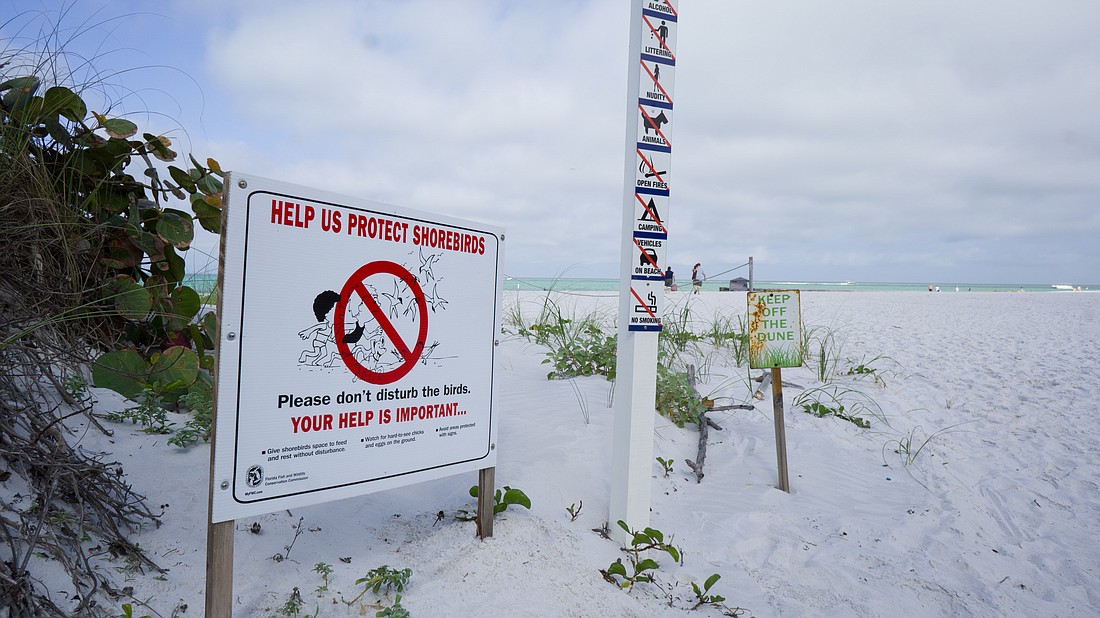- April 26, 2024
-
-
Loading

Loading

It’s that time of year again.
No, it’s not the holiday season. It’s time to break out the additional signage to remind pet owners that no dogs are allowed on Longboat Key beaches.
Co-chair of Longboat Key North Maureen Merrigan said she and others have been noticing more dogs on the beaches, specifically early in the morning and at sunset, despite the town of Longboat Key’s ordinance.
Merrigan began reaching out to town staff to address the concerns. Meanwhile resident Cyndi Seamon was catching wind of the discussions about the issue at hand and decided to lend a hand.
“When I caught wind of possibly some dog issues, I went ahead and asked Public Works if I could go ahead and get those signs,” Seamon said.
For the past couple years, she has been helping to put up larger signs that advise beachgoers to be mindful of the beach habitat.
The signs are currently at the Broadway Street and North Shore Road access points.
“I think it really is, like a lot of things, just about enforcing the ordinance and the rules,” Seamon said.
Merrigan agreed. Police enforcement and visibility makes a huge difference, she said, especially for those people who see the signs but don’t care.
Chapter 92 of the town’s Code of Ordinances outlines activities of public beaches, access points and parks.
It states that all pets, “other than animals certified and utilized for assisting persons with disabilities,” are prohibited from town parks, beaches and public beach access points.
Further, it says unleashed dogs are only allowed within the dog park at Bayfront Park.
Merrigan and Seamon both mentioned that some of the dog tracks seen on beaches have appeared to have been from dogs off leashes.
According to emails between Town Manager Howard Tipton, Merrigan, Seamon and other town staff, the fine for having dogs on the beach is $100 for the first offense, $250 for the second and $500 for the third.
He also added that both the police and code enforcement officers can write the citations, and that when sea turtle season starts on May 1, code enforcement will be out on the beaches more.
According to Audubon Florida, some of the best habitat for migrating shorebirds is on the tips of barrier islands — like Beer Can Island and the north end. There, the birds can find a good mix of breeding habitat and feeding grounds.
“Disturbance from human activities is a leading threat to nesting shorebirds and this can be partly minimized by protecting nesting areas with posted signs to prevent people and pets from disturbing a nesting colony by inadvertently getting too close,” according to the Florida Fish and Wildlife Conservation Commission.
With an increasing number of residents back for the season combined with visitors for spring break, it’s kind of like a “perfect storm” that lines up with the shorebird nesting season, which lasts from Feb. 15 to Sept. 1.
“It's just that time of year where there's a lot of birds on the beach,” Seamon said.

Protected bird species that nest on Florida beaches include black skimmers, least terns, American oystercatchers, Wilson’s plovers and snowy plovers.
As of mid-March, Seamon said there weren’t any nests reported on Longboat Key yet. But there are still shorebirds on the beaches, and disturbing them can be stressful for them.
“Your dog can be the most well behaved dog and great, but the birds don't know that,” Seamon said. “You know, the bird still sees your four-legged friend as a predator.”
Information from the FWC states that birds tend to react differently to dogs than they do humans.
“They fly away from dogs sooner, they go further away, and they are more reluctant to return to the area, which means they leave eggs and chicks vulnerable and have less time for critical activities like finding food that they need to survive,” according to the FWC.
Beaches in Florida are commonly used as a stopping point for migratory bird species. Migratory shorebirds, though they may not have nests on the beach, need to take ample time to rest in between flights.
Red knots are a common migratory bird that could be found on Longboat Key beaches. This species makes one of the longest migrations of all animals, and the Southeast U.S. is listed as one of the common flyover stops for these birds.
During these rest periods, the birds need time to eat and rest in order to gain enough energy to continue on the journey. When disturbed, it takes away from birds’ rest time.